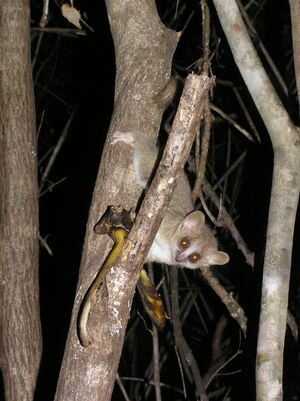Press release of the Leibniz Institute for Zoo and Wildlife Research from January, 13, 2023
Madagascar is home to a unique biodiversity with a large number of endemic species, among those many lemur species, including the mouse lemurs. This diversity is also found in their retroviruses, a team led by scientists from the Leibniz Institute of Zoo and Wildlife Research (Leibniz-IZW) and the University of Stirling reports in the journal “Virus Evolution”. They analysed the mouse lemur genome and identified viruses of two classes that represent ancient infections of the mouse lemur germline. The viruses now behave similarly to lemur genes and are thus called endogenous retroviruses (ERVs). It was surprising that some of the identified retroviruses are closely related to viruses found in other, very different mammals such as polar bears or domestic sheep. This suggests an intriguing and complex pattern of host switching of retroviruses, much more complex than previously thought.
For their analysis, the team collected blood samples from four species of Malagasy mouse lemurs and screened them using high throughput sequencing. The scientists identified two gamma and three beta retrovirus sequences in the lemurs’ genomes, representing ancient infections of the mouse lemur germlines. Since then, the virus DNA has been incorporated in the host genomes and the viruses are no longer active or infectious. “We were surprised to find that one of the two identified gamma retroviruses was related to an ERV described in polar bears”, states Dr Sharon Kessler, a German Academic Exchange Service (DAAD) supported scientist and Assistant Professor at the University of Stirling. The polar bear virus is young from an evolutionary point of view whereas the lemur virus is old. “How these related viruses infected such geographically separated species is unclear”, Kessler says.
There were further surprises among the beta retroviruses. A virulent retrovirus that infects domestic sheep called Jaagsiekte sheep retrovirus (JSRV), which also forms ERVs in domestic sheep, is thought to be a virus confined to domestic sheep, goats and their relatives – the first cloned sheep “Dolly” had to be euthanised after a JSRV infection and subsequent illness. The mouse lemurs have a closely related JSRV-like virus in their genome. “This suggests that JSRV-like viruses have been more widespread among mammals and are considerably older than previously thought. Why they only show up in such disparate species and in such a punctuated way is curious”, says Prof Alex Greenwood, head of the Leibniz-IZW Department of Wildlife Diseases, where the sample screening was conducted. Similarly, the team also identified a virus in the mouse lemurs related to retroviruses found in squirrel monkeys, vampire bats and marsupials. “This group of viruses is becoming more interesting over time as more and more examples of similar viruses are being found in many places including very young ones that may still have currently infectious exogenous counterparts in nature”, says Greenwood.
Much of the mouse lemur retroviral diversity observed is associated with non-primate viruses, suggesting a complex pattern of viral host switching around the time the ancestors of lemurs colonized Madagascar. Further studies of viral diversity will help to clarify the complex history of retroviral transmission among mammals.
Dr Kessler and Prof Greenwood collaborated with Prof Solofonirina Rasoloharijaona of the University of Mahajanga, (Madagascar), Prof Ute Radespiel of the University of Veterinary Medicine Hannover, Foundation, (Germany) and Dr Kyriakos Tsangaras of the University of Nicosia (Cyprus) in this scientific investigation that was also made possible with funding from the American Association of Physical Anthropologists.
Retroviruses are viruses that replicate by incorporating their genetic material into the genome of a host cell. If the infected cell is a germ cell, the retrovirus can subsequently be passed on as an “endogenous” retrovirus and spread throughout a population as part of the host genome. Repeated infections have resulted in endogenous retroviruses being ubiquitous in mammalian genomes, sometimes making up significant portions of the host genome. However, most retrovirus integrations are very old and already degraded and therefore inactive – their initial impact on host health reduced by millions of years of evolution.
Publication
Kessler S, Tsangaras K, Rasoloharijaona S, Radespiel U, Greenwood AD (2022): Long-term host-pathogen evolution of endogenous beta- and gammaretroviruses in mouse lemurs with little evidence of recent retroviral introgression. Virus Evolution, veac117. DOI: doi.org/10.1093/ve/veac117
Contacts
Leibniz Institute for Zoo and Wildlife Research (Leibniz-IZW)
in the Forschungsverbund Berlin e.V.
Alfred-Kowalke-Straße 17, 10315 Berlin, Deutschland
Prof Alex D. Greenwood
Head of the Department of Wildlife Diseases
phone: +49 (0)30 5168255
email:
Jan Zwilling
Science Communication
phone: +49305168121
email:
University of Stirling
Faculty of Natural Sciences
Cottrell Building Room 3B92, Stirling, FK9 4LA, Scotland
Dr Sharon Kessler
Lecturer/Assistant Professor in Psychology
phone: +44(0)1786 467 651
email:


